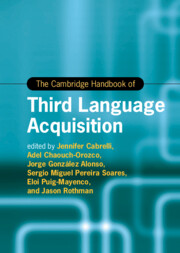Book contents
- The Cambridge Handbook of Third Language Acquisition
- Cambridge Handbooks in Language and Linguistics
- The Cambridge Handbook of Third Language Acquisition
- Copyright page
- Contents
- Figures
- Tables
- Contributors
- Introduction Multilingualism
- Part I Theoretical Approaches to L3/Ln
- 1 Generative Approaches to Third Language Acquisition
- 2 The Usage-Based Approach
- 3 Third Language Acquisition from a Complexity Dynamic Systems Theory Approach
- 4 A Critical Sociolinguistics Perspective on L3 Acquisition
- Part II L3/Ln across Linguistic Domains
- Part III Becoming and Staying Multilingual at Different Ages
- Part IV L3/Ln in Action
- Part V L3/Ln and Cognition
- Part VI Research Methods in L3/Ln
- Index
- References
3 - Third Language Acquisition from a Complexity Dynamic Systems Theory Approach
from Part I - Theoretical Approaches to L3/Ln
Published online by Cambridge University Press: 13 July 2023
- The Cambridge Handbook of Third Language Acquisition
- Cambridge Handbooks in Language and Linguistics
- The Cambridge Handbook of Third Language Acquisition
- Copyright page
- Contents
- Figures
- Tables
- Contributors
- Introduction Multilingualism
- Part I Theoretical Approaches to L3/Ln
- 1 Generative Approaches to Third Language Acquisition
- 2 The Usage-Based Approach
- 3 Third Language Acquisition from a Complexity Dynamic Systems Theory Approach
- 4 A Critical Sociolinguistics Perspective on L3 Acquisition
- Part II L3/Ln across Linguistic Domains
- Part III Becoming and Staying Multilingual at Different Ages
- Part IV L3/Ln in Action
- Part V L3/Ln and Cognition
- Part VI Research Methods in L3/Ln
- Index
- References
Summary
Over the last years it has become clear that the investigation of the complexity and the dynamics of multilingual development and use needs to be approached from a new research perspective. This challenging scientific undertaking is not considered an additional approach but a replacement for the common traditional monolingual framework still applied in studying language development.By drawing on recent international research in the field of applied linguistics, this chapter provides an update of the Dynamic Model of Multilingualism (DMM) authored by Herdina and Jessner (2002) which presents the first monograph applying a CDST (complexity and dynamic systems theoretical) approach to multilingual development and use. The holistic perspective of multilingual development and use as a necessary prerequisite of the approach presented in the DMM will be unfolded by increasing the complexity in interaction of levels of inquiry in the study of third language acquisition and multilingualism.
- Type
- Chapter
- Information
- The Cambridge Handbook of Third Language Acquisition , pp. 64 - 95Publisher: Cambridge University PressPrint publication year: 2023
References
- 1
- Cited by

